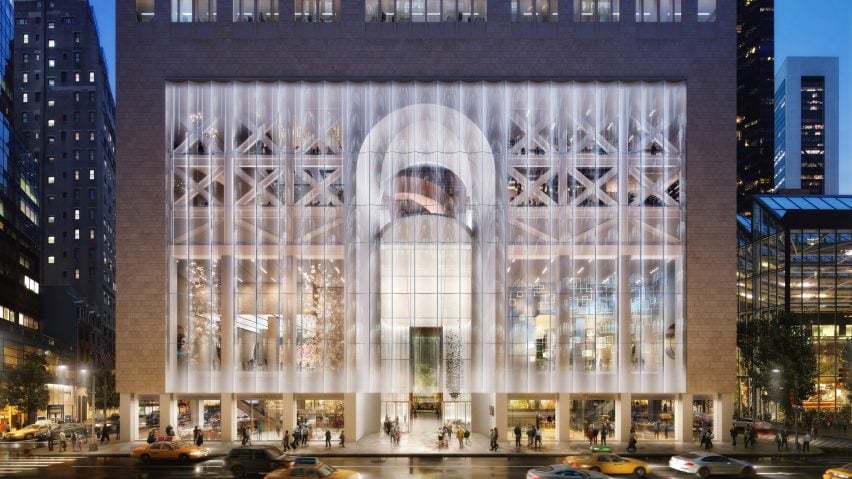Architecture firm Snøhetta has revealed plans to overhaul the New York skyscraper formerly known as the AT&T Building – an icon of postmodernism designed by Philip Johnson and John Burgee.
The 647-foot (197-metre) tower – also previously known as the Sony Tower, but now named 550 Madison – will receive a makeover that will update its public, retail and office spaces.
Snøhetta plans to retain the building's recognisable classical pediment, but will transform its "fortress-like base" with an undulated curtain wall of translucent glass, opening up the lower levels so passers-by can see in.
"While the recognisable top of the tower will remain a fixture of the New York City skyline as it has since its completion in 1984," said the studio. "The new design will transform the base into an inviting street front, extending the lively activity of Madison Avenue further south to 55th Street."
"From the street, the reconceived facade dramatically highlights the multi-story arched entry while revealing the craftsmanship of the building's existing steel structure," the firm added.
The AT&T Building is regarded as the first skyscraper in the postmodern architectural style – a movement that emerged in the late 1970s as an ideological reaction against the utopian ideals of modernism.
However the building has sat vacant since electronics giant Sony left a year and a half ago.
It was originally designed for single-tenant use, and the interior updates are intended to modernise the offices and help lease the floors to multiple companies. More retail and restaurant spaces, and other amenities, will be included to help entice occupants.
The outdoor space beside 550 Madison will also be opened up, doubling the amount of publicly accessible space on the site.
An annex building will be removed from the passageway connecting 55th and 56th Streets behind the tower, and the area will be planted with seasonal foliage to create a place for eating lunch or relaxing.
"Snøhetta's design approach stitches the life of the building back into the street," said the firm.
The building will also be fitted with a dedicated outdoor air ventilation system (DOAS), which will supply clean fresh air to the offices and consume less energy than a typical mechanical ventilation system.
Johnson was a seminal figure in modernism. He played a key role in introducing the style to America in the 1930s, promoting the work of European architects including Le Corbusier and Mies van der Rohe, and building many seminal modernist buildings himself – notably his 1940s Glass House in Connecticut.
However he later dramatically switched style and adopted postmodernism. The unveiling of the AT&T Building marked a key shift in architectural discourse.
Johnson and Burgee gave the tower granite cladding and a "Chippendale" roof line, while brass and marble finishes featured on the interior – a distinct shift from Midtown's glass and steel skyscrapers at the time.
Snøhetta has offices in Oslo and New York. The firm's work in the US includes the recent transformation of Times Square and an extension to the San Francisco Museum of Modern Art.
Renderings are by DBOX for Chelsfield.

